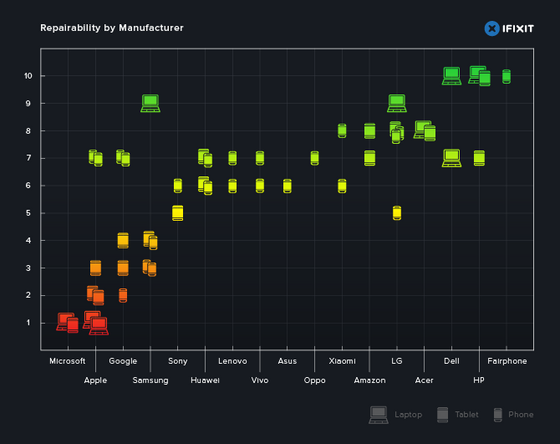Repairability is going global. Today, Greenpeace published its consumer guide to greener electronics, which—for the first time—includes repairability as the primary component of its scoring system.
Of course, iFixit assesses devices for repairability all the time—so we partnered with Greenpeace to disassemble and rate 44 recent devices from 17 different manufacturers, including Apple, Google, and Samsung. The ratings considered ease of disassembly, along with the availability of replacement parts and repair guides.
Why all the hullabaloo about repair? Electronics need to be a more sustainable part of our lives. Sure, our gadgets are getting thinner and lighter, but they still require a massive outlay of natural resources, contribute to greenhouse gas emissions, and gobble up a lot of energy during their lifetime. All that for devices designed to last just a few years.
Sustainable devices are devices that are designed to have a long life—and that means prioritizing repair and upgradability. Plus, devices that are easier to disassemble are also easier to recycle. Reusing, repairing, and recycling are always greener than manufacturing something anew.
“Making devices that can be easily repaired and are designed to last is the most significant step that companies can take to reduce the environmental impacts of making our electronics! In the meantime, by using the electronics you already own for as long as possible and fixing them when they break, you are helping to save the planet’s finite resources,” says Greenpeace.
The results of Greenpeace’s assessment can be seen on the scorecard website, Rethink IT. While you’re there, share the campaign and sign a petition to voice your support for repairable products. You can also read Greenpeace’s full report here.
But if your bus ride is almost over, here’s our tl;dr.
As you can see, devices—on average—scored in the upper range, indicating that many devices still retain a relatively high degree of repairability. But Greenpeace’s results also show that many newer devices have lower scores than their predecessors, indicating that the market is trending towards less repairable designs.
Here are a few other takeaways from the report:
- Repairability is partially “genetic”: Laptops are still the most repairable portable electronic, on average. Which is good, they’re pricey and they should last. Apple and Microsoft haven’t gotten the memo, though. Unfortunately, Apple’s line of notebooks and Microsoft’s Surface Book were the least repairable laptops we assessed. Apple did buck their trend towards unrepairable devices with the iPhone, which is a fairly repairable device.
- Things could be so much better: Manufacturers like Apple and Samsung are self-sabotaging by offering repairable devices in some form factors, but not others. And the old “can’t-be-done” argument isn’t a good one—there are devices that manage to be slim and repairable from other manufacturers in each category. It can be done, and has been done.
- Adhesive means an early death: Of the devices we analyzed, 70% were equipped with difficult to replace batteries, and an embarrassingly low number—just 7%—were intended to be user-replaceable. If the battery can’t be replaced, it’s a matter of just a couple of years before the device needs to be plugged in all the time. Easy-to-replace batteries make repairs easier, cheaper, and more accessible for consumers. And a device with a battery that’s easy to replace is less likely to end up being e-waste in short order. Which is why we always advocate for minimal battery adhesive or removable adhesive tabs.
- Knowledge is power: Very few electronics manufacturers provide users with information about how to fix their products. We found that only three brands—Fairphone, Dell, and HP—consistently provide repair manuals and spare parts.
The price of a device isn’t just the sticker, or the monthly payment; it’s also the next device you have to buy because you broke the screen. Or because the battery wore out. It’s also the cost of e-waste and the toll manufacturing takes on the environment. Like EnergyStar, repairability should be a tool consumers arm themselves with to make good buying decisions.
As always, you can check out our smartphone, tablet, and laptop repairability lists for your repairability and upgradability knowledge.
Header image courtesy of Greenpeace





crwdns2944067:00crwdne2944067:0